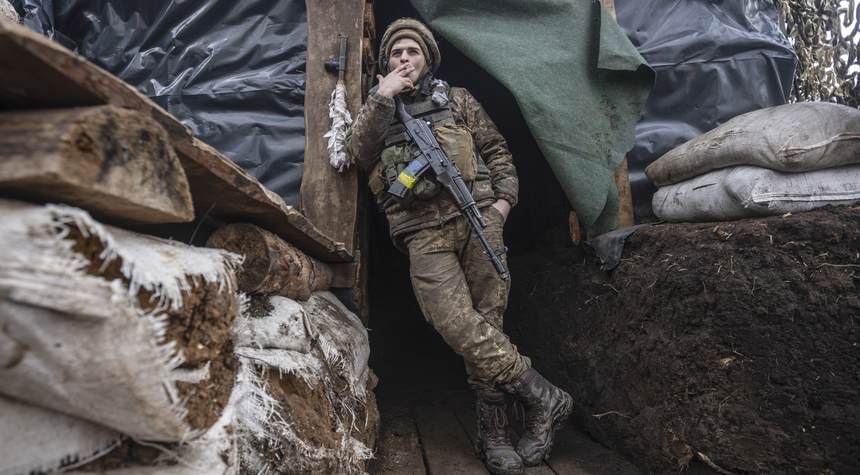US and Allies Raise Stakes, Turning Putin's Ukraine Fantasy into Risky Nightmare
News reports on Monday, January 24 state that President Biden has begun to put US troops on high alert that they may be deploying to Eastern Europe and that US troops will be symmetrically deployed to the west of Ukraine opposite Russian forces, thus surrounding the beleaguered nation on both sides.
Nine hundred miles east of the Cold War’s Fulda Gap, Ukraine has become the 21st Century version of the contest arena for the latest test of wills in Europe’s long history of power struggles between the children of the Caucuses.
As of this week, the United States and the European Union are in a race to turn Ukraine from a place where Russian President Vladimir Putin saw an opportunity to pursue his next Crimean annexation into a costly economic and political risk for Russia.
That risk jumped massively with the beginning of shipments of anti-tank and anti-aircraft weapons tricking into Ukraine from neighboring countries along with advisers to train the estimated 280,000 troops of the Ukrainian Army in their use.
Risk mitigation by the US intelligence has been ongoing throughout the Russian build-up. The New York Times reported that surveillance aircraft have been flying to monitor both ground forces as well as to determine if Russia’s tactical nuclear arsenal is part of Mr. Putin’s plans for conquest.
The US risk assessment is such that the response escalation approved by US President Joseph Biden and other European nation suppliers is historic. Putin should have no doubt about the West has signaled that Ukraine is now a de facto NATO member. The chessboard has changed permanently.
This puts a strain on Putin’s strategy of intimidating Ukraine as he massed up to 100,000 Russian troops east of Ukraine in December from as far away as the eastern frontier of Russia. Mr. Putin has positioned nearly one-third of his army in a show of force.
But time is not on the side of Mr. Putin in these deployments. Moving troops out of their bases for exercises is expensive and eventually degrades readiness to fight. Pre-positioning equipment away from troops similarly degrades readiness because training and maintenance is disrupted.
In contrast, NATO’s support to Ukraine’s defense will grow in effectiveness as time drags on. Stockpiles of weapons, battle plans, and training to thwart a Russian mechanized warfare attack will steadily improve as 2022 moves forward. The force ratio of attacker and defender will begin to move towards parity and create a stable deterrent against invasion.
Trying to Stay in the “Grey Zone”
If the US and NATO strategy succeeds, the conflict goes back to what’s called “Grey Zone” warfare which is dominated by angry and animated economic, political, and military posturing.
In a “Grey Zone” fight, the Western countries, and their willingness to adapt to the realities of a protracted economic divorce from Russia, will be tested. Because of the EU’s dependence on Russian energy pipelines, I anticipate that one of the costs to the West will be having to reset its attitude towards climate change. Europe needs fuel and electricity. This means that if they can’t get Russian oil and gas, they’re going to have to invest in things like nuclear energy and even facilitating alternative pipelines such as the Iran’s dream of supplying Europe with gas via a Fertile Crescent route. The US too may have to consider gearing up to domestic oil production as Western Europe’s demand changes the global supply chain matrix. Yes, what Mr. Putin is doing will have those kinds of “collateral” effects. Nothing changes “woke” like waking up and smelling the coffee. This narrative in the news cycle is coming.
More important in the present for Mr. Putin’s consideration is that the nations of both NATO and the former Warsaw Pact are voting with their feet with regards to his vision. They are siding with the Ukrainians. That’s a cultural reality that Russia, with or without Mr. Putin’s leadership cannot be ignored forever. Quite honestly, that war for the minds of Europeans by Putin has already been lost. His notion that “Ukrainians are one people, one country” is correct. But it’s not a Russian fantasy, it’s a European dream. Each week that goes by solidifies these cultural ties further.
When it comes to long haul siege craft, wealth matters. Europe is richer than Russia. Europe has the wealth of the United States bolstering its staying power. The cost to set up and maintain a defense of Ukraine over the long run is cheaper than the cost to build the forces needed to invade the country.
Present day battlefield technology is on the side of the defender, as was shown in Syria in February 2018 when US defenders decimated a Russian private army column. In a war, you’ll eventually run out of S.400 air defense sites and air superiority attrition will result in Ukraine becoming airspace enforced by Western air power with local government invitation, even if Russia and China veto UN Security Council resolutions.
The bottom line is that time is not on Mr. Putin’s side. Personally, I’d be exploring ways to defuse the situation before internal confidence within Russia for his aggressive policy becomes his own political liability.
As noted in my previous article last week, “Analysis: Putin’s Dangerous Ukraine Brinksmanship Fantasy Needs to Stop“, I continue to recommend that the West ponder alternative exits for Russia from the predicament it has cornered itself into; including, but not limited to, offering Russia a path to becoming a full member of the Western alliance with stringent conditions. Yes, I know it’s a wild card and I’ve been told such a thing is impossible. But someone also told me (a long time ago) that it was impossible to end the Cold War, and yet it happened.





Post a Comment